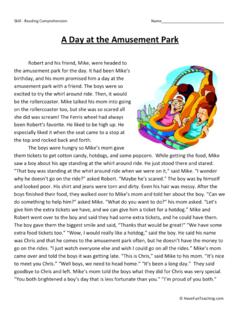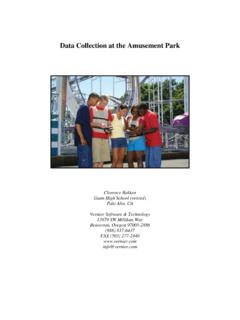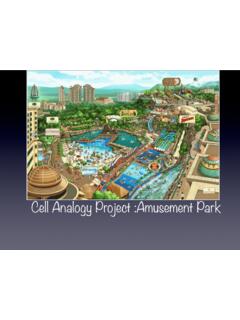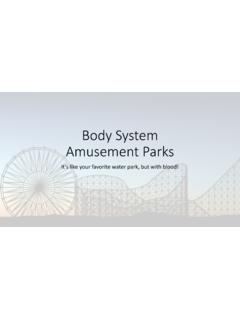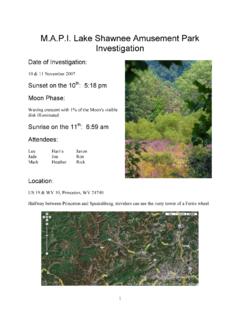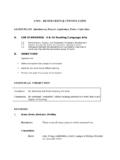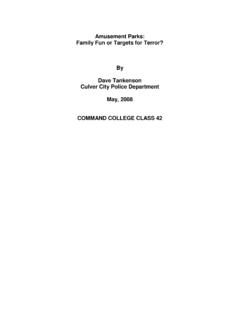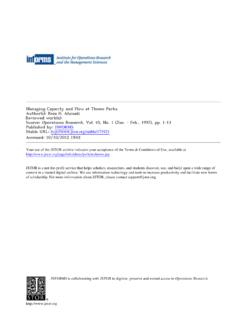Transcription of HANSON’S AMUSEMENT PARK - Harveys Lake
1 hanson S AMUSEMENT park I. The Early Years 1891-1909 In earlier years railroads and trolley companies stimulated passenger traffic by constructing parks at scenic areas along the rail lines. After the Lehigh Valley Railroad purchased the Harvey's Lake and Wilkes-Barre Railroad in 1887, it planned to develop a major resort along the lakeshore. In November 1889 several tracts of land between Alderson and Barnum Place were purchased by the railroad in order to construct the Harvey's Lake Picnic Grounds. By early June 1891 the Lehigh Valley Railroad was preparing to open its splendid new park at the Lake. Well-shaded and ideally located, the major attraction of the park was the 150 foot dance pavilion, the largest in the region. On June 9, 1891, twenty train cars, run in three sections, transported the Odd Fellows from Wilkes-Barre and Pittston for the first major picnic at the new park .
2 William Bond had launched his Big Boat, the new seventy foot steamer, a few weeks earlier and he was ready for the event. On the lakeshore at the new Picnic Grounds the railroad built an immense L-shaped dock. It was 180 feet long with a ninety foot arm. The dock would accommodate Bond's Big Boat, his smaller City Charter and the Mistletoe, a small steamer owned by the Rhoads Hotel. Bathing houses were also constructed at this time along the park 's shoreline. 1 The Harvey's Lake Picnic Grounds was an immediate success. Additional features for the following year were planned. By May 1892 the dance pavilion was being prepared for another season's use. C. F. Cook, the Wilkes-Barre photographer, opened a gallery at the Picnic Grounds in June. The steamer dock, which was moved several feet by the winter ice, was repaired, but plans by the railroad to construct a large hotel at the park grounds for the 1892 season were never completed.
3 For a decade the Picnic Grounds served as a popular park for families to gather for picnics and for couples to stroll along the lake shore. In 1903 the park grounds were still primarily shaded areas with picnic tables. A Merry-Go-Round was operating at the park , but the only other AMUSEMENT device at this time was a crude bowling alley. The railroad line from Alderson ran along the lakeshore and turned into the park to leave passengers at the small Harvey's Lake substation, which was located behind the dance pavilion. Passenger cars chartered for picnic excursions would layover on a side track at the park for the day. W. F. Clark now held the photograph gallery in the front of the park at Noxen Road. For the 1906 season the Lehigh Valley "Railroad leased the park to John A. Redington, who also owned the Redington Hotel in Wilkes-Barre. But late In the same year, on December 12, 1906, the dance pavilion was lost to fire along with the original carousel that had been stored inside the pavilion for the winter.
4 The park then leased a lot along the Noxen Road toward the rear of the park to H. F. Seibert for a small Merry-Go-Round, and a new dance pavilion was constructed at the site of the old one. 2 II. Creating An AMUSEMENT park 1908-1934 Conversion of the Picnic Grounds to an AMUSEMENT park began in the summer of 1908. Large picnic excursions were arriving at the grounds on a daily basis. In this year an arcade with "moving picture" machines was added and a Ferris Wheel was constructed. On July 4, 1910, the record-breaking crowd at the Picnic Grounds bought 15,000 tickets to the new figure-eight Coaster owned by Charles Shelley. The Roller Coaster ran single cars, each carrying four to six passengers. The Coaster had its own organ for musical accompaniment. The Miniature Railroad owned by Fred Thomas was also added to the park . The steam operated train, an exact replica of a steam locomotive, was built in Tonawanda, New York.
5 The operator sat on the tender car and pulled two passenger coaches. The Lake was cresting as a major resort in 1910. There were daily train excursions planned for all of July and August. In addition to the park amusements, hundreds would crowd the park beach. Boating parties were common as tourists could take steamboat rides or sightseeing launches around the Lake. When Charles Shelley built the Coaster, he also built the Shoot-the-Chute, an enormous attraction. The Shoot-the-Chute was about sixty feet high and was built along the water's edge, next to the steamboat landing. The wooden slide had rows of small rollers down the entire length of the long chute. Single, double or triple sleds were rented by the hour. The sleds were taken up a long ramp and three flights of stairs to the top of the Shoot-the-Chute. With elbows and legs tucked in and hands gripping the rope, youths raced the sleds down the Chute finishing with a grand splash into the Lake.
6 3 In the spring of 1915 a new steam operated Merry-Go-Round was added to the Picnic Grounds. The Merry-Go-Round, with forty-four wooden horses and two chariots, lasted until the park closed. In April 1916 the Lehigh Valley Railroad renewed the park lease with Redington for fifteen years. As with earlier leases, the railroad reserved its track line through the park , and sale of liquor in the park was prohibited, a condition frequently violated by transient and unlicensed salesmen. Redington was assisted in the management of the park by Charles Lee and George Heller. In July 1921 the old restaurant was removed and a new enclosed restaurant was constructed by George H. Jenkins. The restaurant was managed by Alfred Wintersteen; the second floor was a dance area. On July 4, 1921, the ten-piece MacLuskie's Orchestra provided afternoon and evening dance music for the opening of the new dance pavilion.
7 Redington, Lee, Heller, and Wintersteen planned to purchase the park from the railroad, and in anticipation of the sale, the four men created the Harvey's Lake park Company in 1922. On July 5, 1923, however, the railroad sold the park directly to Redington who, in turn, leased the park to the new corporation. Other transactions over operation of the park would follow. The park corporation subleased the park to Redington and Lee. In October 1923 Redington and Lee, in turn, leased the park to Alfred Wintersteen for fifteen years. Harvey's Lake park totaled twenty-five acres. 4 Wintersteen converted the dance pavilion behind the restaurant into the Dodgem ride. Nettie Wintersteen managed the Dodgem ride and assisted her husband, Alfred Wintersteen, in the management of the park . For years the beach was supervised by Howard Major who also managed the Shoot-the-Chute, which had been acquired by the park owners from Shelley.
8 The Noxen Road was also an area growing with attractions. Irwin A. Rood, the West Corner grocer, had a ten-pin alley and game stands on the park side of the Noxen Road until 1933. In May 1930 the lease with Wintersteen was merged into a sale of the park to Nettie Wintersteen since her husband, Alfred Wintersteen, had become disabled. In 1929 John E. hanson had joined Nettie Wintersteen in the management of the park , and when the May 1930 sale to Wintersteen was arranged, Wintersteen sold a one-half interest in the park to hanson . In the spring of 1931, the sixty-five foot high Roller Coaster was built by John A. Miller and Oscar E. Bittler at a cost of $10, The Roller Coaster was built over the Lehigh Valley rail line which turned from the lake's shoreline and passed through the Picnic Grounds. The Speed Hound, the name of the Roller Coaster, was not generally used, although the coaster itself enjoyed great popularity.
9 Electric lighting was not in general use at the lake until 1927, when hanson arranged to light the park for late evening use, especially for graduation parties after the new Roller Coaster was built. The Merry-Go-Round was also converted to electric operation. Redington had retained ownership of the bathing beach and bathhouses in the May 1930 sale to Nettie Wintersteen. Still, Wintersteen and hanson promoted beach attractions as much as the park and amusements. The Picnic Grounds helped to promote annual boat races, usually in a triangular two and one-half mile course around the Lake, with the Picnic Grounds as a favorite viewing point. For a time Alex, a tame bear, delighted the crowds as he wrestled the local talent. The bear was originally owned by Ralph A. Davis, who later raffled the bear to Emory Newell of Noxen. 5 At the intersection of the lake road and Noxen Road Charles Lord's was also a popular roadside stop and in one weekend at this time he sold 1,500 hot dogs.
10 The largest picnic of the season was always the Coxton Yards Welfare Association, whose annual excursions to the Lake began in 1925. In 1933 the Coxton Yards excursion brought thirty train cars of guests to the Lake. To close the 1933 season the Picnic Grounds offered its first Children's Day in mid-September and 15, 000 children were offered free rides and refreshments. In May 1934 Redington agreed to sell the beach to Wintersteen and hanson . For the 1934 season the owners assumed direct control of the bathing area; Howard Major moved to a corner of the beach next to Lord's restaurant where he rented canoes and rowboats for another two decades. At the time of the sale, the beach had two hundred feet of boardwalk in the water and a forty-foot high diving platform. There was no admission charge to the beach, although there was a small charge for use of the bathhouses.


